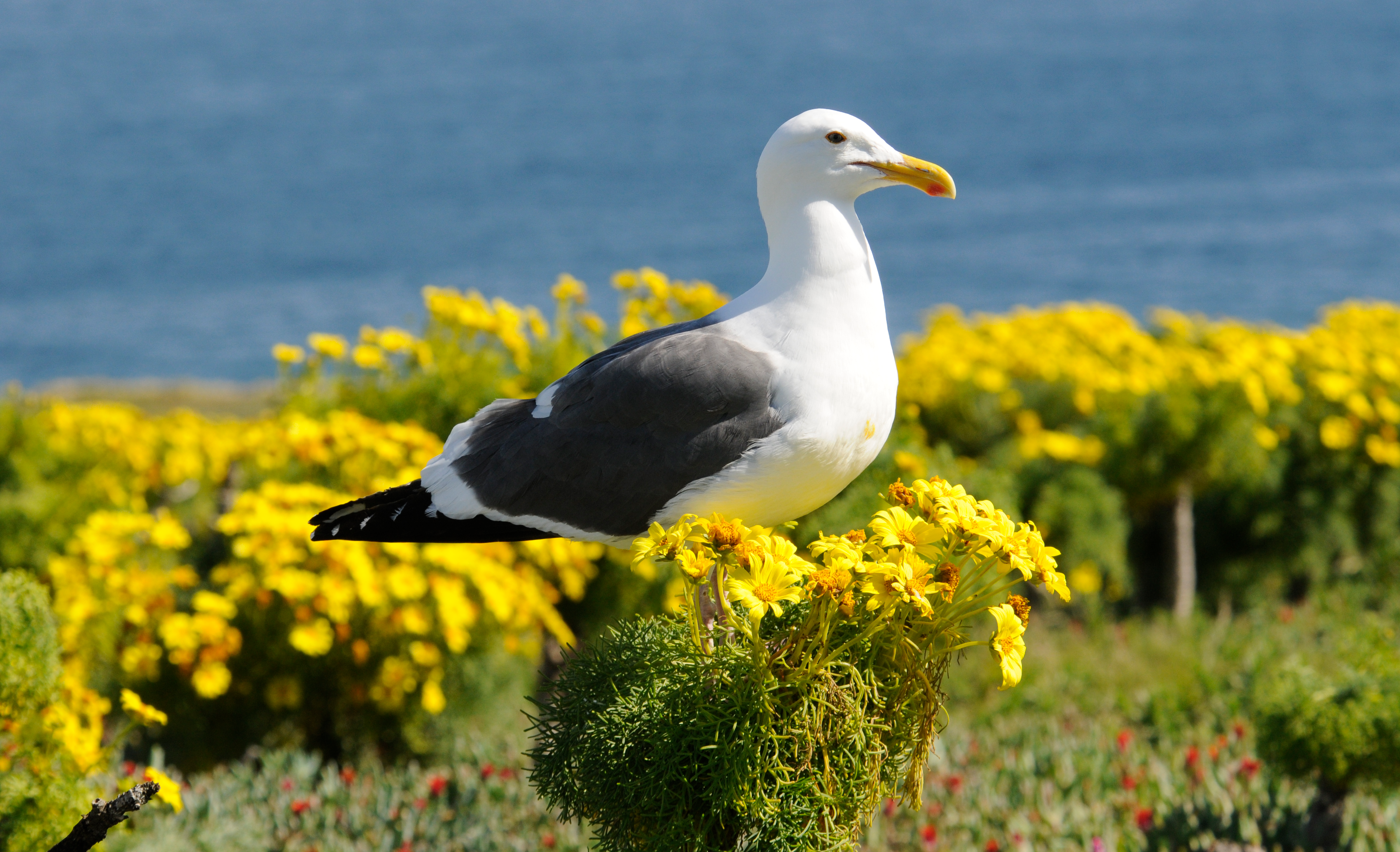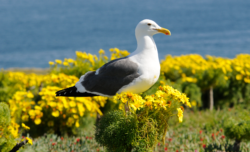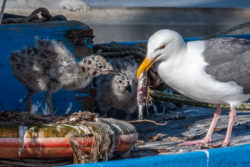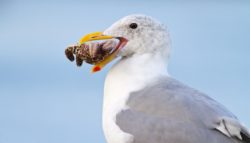
Sea Wonder: Western Gull

Western Gull perched on Anacapa Islands within Channel Islands National Marine Sanctuary. Photo: Robert Schwemmer
We might not think of birds as important parts of marine ecosystems, but these migratory marvels keep food webs in balance, bring nutrients to islands and other areas, and serve as sentinels of the sea – giving us clues about the health and quality of the ocean through their own individual and population health. Many bird species – not just seabirds – travel through the sites within the National Marine Sanctuary System, taking refuge on islands, rocky shores, and in mangrove forests during their annual migrations. One of these birds is the Western gull (Larus occidentalis), a pretty typical looking bird you might see at or near the beach. All gulls may look the same to the untrained observer, but the Western Gull’s larger size and darker feathers on its back set this species apart from other gulls.
Description
Western gulls are medium-sized birds with stocky frames. When fully grown, they can weigh about two pounds and reach lengths of a little more than two feet. Their bodies are mostly covered with bright white feathers, including on their large head, neck, chest, and underside. On their back and wings are dark grey feathers, and black feathers with white spots at the rear edges of their wings. Their beaks are thick and bright yellow, dotted with two nostrils on their top bills and a red spot on the front of their lower bills. They have pink legs, webbed feed, and either dark brown or olive-yellow eyes depending on which subspecies an individual is.
Adult males and females are nearly identical in their appearance, but males are slightly larger in size when fully grown.
Diet & Habitat
Western gulls are strict carnivores that mostly feed on fish and marine invertebrates, though they will pick at terrestrial prey too, such as insects, earthworms, and carrion – the decaying tissue of organisms. Gulls swallow their prey whole and are opportunistic feeders and will sometimes eat things they aren’t supposed to like plant matter, plastics, and food given to them by humans. They don’t venture far from the coast, but will look for food along beaches, in intertidal areas, and even in urban areas near the coast.

Western gull feeding its chicks in Monterey Bay National Marine Sanctuary. Photo: Douglas Croft
This species has an impressive variety of foraging strategies at its disposal, each used for a specific kind of prey or in a certain scenario. They can pluck critters from shallow waters, dive below the water’s surface for a brief time, dig unsuspecting prey out of the sand or sediment, and even fly high with shellfish in their mouths, dropping their prey on rocks to break open their shells and reveal the tender flesh inside. These sneaky, smart birds often follow marine mammals, other large predators, and fishing boats jumping in on the action and minimizing their own efforts to find and hunt. They are also known for stealing food, whether from other birds or even other kinds of animals. On land, they scavenge carrion on the beaches, will eat placenta left behind from sea lion rookeries, and on very rare occasions they will snatch up small mammals like rats and bunnies.
Western gulls live along North America’s West Coast, ranging from British Columbia down to Baja California in Mexico. They are common along the rocky beaches of the Pacific coast and can fly over the ocean for extended periods of time, and very rarely do they travel inland. Across the National Marine Sanctuary System, we spot Western Gulls near all of the West Coast sanctuaries. Throughout the year, these birds travel to offshore islands for mating rituals, and they make their nests on rocky cliffs, islands, or even abandoned features like piers.
Life History
Western gulls nest in colonies, often with other species of gull, and make their nests by scraping the ground and lining the imprint with whatever they can find – plant matter, trash, feathers, rope, and wood are common examples. Western Gulls establish their colonies near the colonies of other bird species – this is because they are opportunistic feeders and can easily snatch up unguarded eggs or chicks of smaller or more vulnerable bird species.
Western gulls, like other birds, often form pair bonds when they mate. Both parents care for the eggs, and females can lay between one and three eggs per clutch. In rare cases, a female can lay as many as six eggs per clutch. Males and females take turns caring for the eggs over the course of a month and then they hatch. In rare cases where more females are present in a colony than males, females will form pair bonds and both females lay eggs and care for the entire brood.
Hatchlings will spend a few weeks in the nest, receiving food from their parents who leave them alone while they forage. Sometimes, hatchlings will venture out of the nest and hide in nearby vegetation for a few days, but they don’t start flying until they are about six or seven weeks old. At 10 weeks old, they start leaving their nests and living their lives as independent birds. They often switch between traveling alone and traveling in groups of varying sizes. Western gulls reach their full size and plumage at around four years old and the average lifespan of these birds is 15 years, though the maximum is about 25.
Interestingly, Western gulls can breed with the glaucous-winged gull, another species of gull with which they are genetically compatible. This results in hybridized offspring and occurs quite often in the Pacific Northwest. In fact, hybrids of these two bird species are more abundant in that region that either of the original species.
Threats & Conservation
Populations of Western gulls are relatively stable and are a common sight along the Pacific coast. However, colonies have been harmed in the past as a result of pesticides that make physical contact with their nests or by eating prey exposed to these chemicals. They are also at-risk of declining populations as a result of urbanization and habitat loss along the coast, climate-related impacts, ingesting marine debris, and the effects of oil spills and pollution. As their prey move or become more scarce, Western gulls will have to travel greater distances and put more effort into foraging, which also puts hatchlings at risk and may reduce the reproductive rate of the species. The good news, at least for now, is that the International Union for Conservation of Nature (IUCN) Red List considers Western gulls to be a species of least concern based on available data.

A western gull eating a sea star in Olympic Coast National Marine Sanctuary. Photo: Enrique Patino/NOAA
